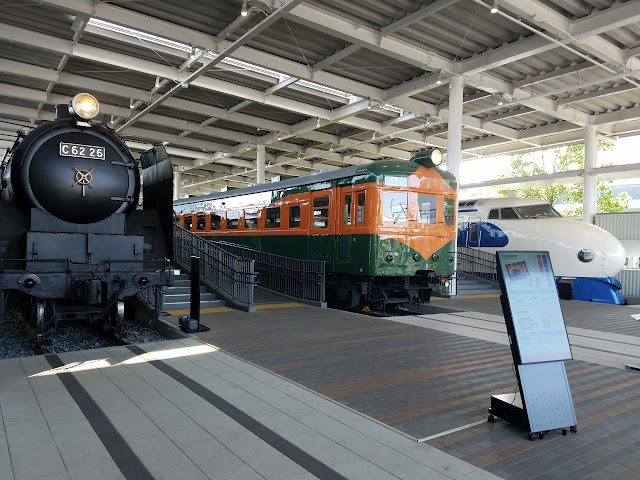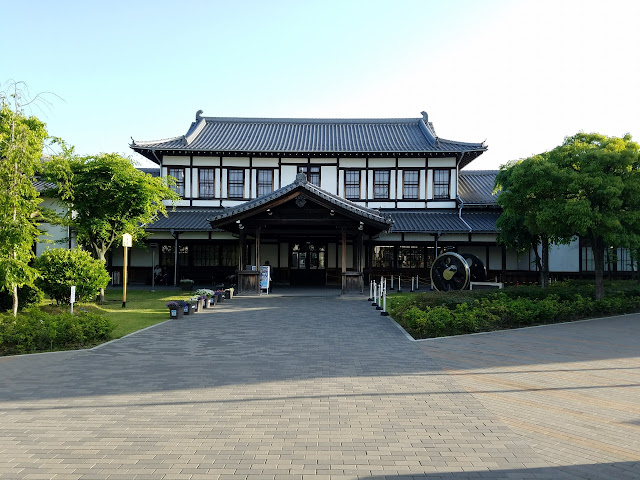Edit 10 October 2019: Updated with information on the new train station opened near the museum.
Previously on Sekai Ichi, I visited the Arashiyama district and the Toei Kyoto Studio Park as part of a day-trip around Kyoto. This eclectic tour continued afterwards with a visit to the Kyoto Railway Museum (京都鉄道博物館, Kyōto Tetsudō Hakubutsukan). This museum is owned by JR West and was newly opened in 2016, replacing the Umekoji Steam Locomotive Museum on the same spot.
After going through the entrance hall, visitors walk out onto a covered promenade, lined by preserved train cars. From left to right, this shot shows a C62-class steam train, an 80-series electric train, and a 0-series Shinkansen train. In particular, the C62 is popular among railfans. Another model, preserved at the SCMaglev and Railway Park in Nagoya, broke the the speed record for steam trains in 1954, and in Leiji Matsumoto's manga and anime series Galaxy Express 999, the space trains were designed after the C62.
The main hall is designed around three more showcase trains. From left to right, they are a 500-series Shinkansen, an 81-series diesel train, and a 489-series "Raicho" electric train. The 500-series Shinkansen, introduced in 1997, was the first of Japan's bullet trains to run at 300 kilometres per hour (185 miles per hour) in regular service.
There is a stronger emphasis on steam engines in this museum, since it was the focus of its predecessor. Japan built its first steam locomotive in 1872, almost a half-century after the first ones made in Britain (1825). It's not this one, however; the 230-class engine shown above, dating back to 1903, is not even the oldest train on display at this museum
Another car preserved in this museum is the front locomotive for the "Sakura" sleeper train. Nicknamed "Blue Trains" for their livery, the first sleeper services in Japan emerged in the mid-1950s. The "Sakura" connected Tokyo and Nagasaki, for example. However, with other emerging modes of transportation -- the Shinkansen, highway buses, and low-cost airlines -- being faster and/or cheaper, JR phased out sleeper services in the 21st century. The Blue Trains are all retired, and the only active sleeper services as of this article are the Sunrise Izumo (Tokyo-Izumo) and Sunrise Seto (Tokyo-Takamatsu). The name "Sakura", meanwhile, was re-used for services on the Sanyo and Kyushu Shinkansen.
There are lots of other exhibits which show the evolution of train travel in Japan over its century-plus history. For example, here are two kinds of ticket gates. The older gates, on the left, required station attendants to stand and check passengers' tickets manually, whereas the newer gates, on the right, can read tickets and IC cards automatically. I imagine that added convenience has helped the increasing passenger traffic over the years flow in and out of stations much more smoothly.
These are conductor uniforms from before and after the dissolution of JNR (Japan National Railways). JNR was a state-owned railway company that formed in the post-war years, and covered the whole of Japan. However, amidst massive debt and declining ridership, in 1987 JNR was split into multiple privately-owned companies, forming the JR (Japan Railways) group of today. This very museum is owned by JR West, which operates in western Honshu.
The collection of memorabilia includes plastic models of meals served on the old trains.
As with any train museum worth its salt, the Kyoto Railway Museum has a big model railway diorama. I must say, however, that it wasn't quite as impressive as the diorama at Nagoya's train museum, because that one was larger and had more details from more cities.
I must also say, however, that I liked other little details such as the simulated cotton smoke coming out of the steam trains at this wheelhouse. ...Which shouldn't even be there if the trains are standing still, but never mind; I think it's cute.
Other model trains, such as the Evangelion Shinkansen, are displayed in separate cases. The real Type-500 Eva had been retired just before my visit, on 7 May 2018. However, on 30 June, it was replaced with a new Hello Kitty-themed Shinkansen.
The Kyoto Railway Museum has quite a few interactive exhibits. Here is one where you can drive model trains around a track by controlling the throttle (right) and brake (left) levers. I don't know how many of you have played the Densha de Go! video games, but it's like that -- only without any time limits to stress over.
Another one lets visitors print their own sample train tickets. There are many options involved in this process, from the starting and ending stations, to the time of departure, to the seat to be reserved. But, all you have to do (and all you can do to move on) is touch the blue-highlighted options as they come up. At the end, the machine will print out a sample ticket for you to take home!
At this station, you can control the display on a departure board. Different combinations of buttons on the console are used to set the name, time, and destination of each of the three listings.
In addition to the simulators and activities I've shown you, there are also train conductor simulators (not pictured). Admission to this simulator is free, but entry is controlled by a lottery system.
The top floor has an observation deck looking out across the railyards of Kyoto Station. I saw a couple of Shinkansen trains passing by, but failed to capture any in photos or videos. I did, however, spot landmarks such as Kyoto Tower (left) and the pagoda of To-ji temple (right).
 |
| By Toshinori baba [CC BY-SA 4.0 ], from Wikimedia Commons |
This building used to be part of Nijo Station, a couple of stops north on the Sagano line. In 1996 it was dismantled as part of the station's remodeling and moved here, where it served as the entrance to the Umekoji Steam Locomotive Museum. Now it serves as the Kyoto Railway Museum's exit and gift shop. I did barely miss the bus I had intended to make, but waiting for the next one (only 15 minutes) gave me time to buy some nice souvenirs. Most of them were related to the Evangelion Shinkansen, of course. Find out where we would eventually head off to, next time on Sekai Ichi!
Hours: Open from 10:00 AM to 5:30 PM. Admission ends 30 minutes before closing time. Closed on Wednesdays (besides national and school holidays), and from 30 December to 1 January.
Costs: ¥1,200. Rides on the steam train cost an extra ¥300. Audio guides, available in Japanese, English, Chinese, and Korean, cost an extra ¥500 to rent.
Address: Kankiji-chō, Shimogyō-ku, Kyōto-shi, Kyōto-fu 〒600-8835
Access: From Kyoto Station, take the JR Sagano (E) line to Umekoji-Kyotonishi station (E02, 3 minutes, 150, JR Pass OK). This station was newly built and opened in 2019.
There is also a bus stop, Kyoto Railway Museum-mae, right in front of the museum, and another, Umekoji Park, two minutes away on foot. Buses serve the former stop more frequently on weekends and holidays than weekdays. From Kyoto Station, take bus #86, 88, 103, 104, or 110 to Kyoto Railway Museum (7 minutes, ¥230), or take bus #86, 88, 205, or 208 to Umekoji Park (9 minutes, ¥230). All of the above buses depart from stand B3.
Website: (English) (Japanese)
Access: From Kyoto Station, take the JR Sagano (E) line to Umekoji-Kyotonishi station (E02, 3 minutes, 150, JR Pass OK). This station was newly built and opened in 2019.
There is also a bus stop, Kyoto Railway Museum-mae, right in front of the museum, and another, Umekoji Park, two minutes away on foot. Buses serve the former stop more frequently on weekends and holidays than weekdays. From Kyoto Station, take bus #86, 88, 103, 104, or 110 to Kyoto Railway Museum (7 minutes, ¥230), or take bus #86, 88, 205, or 208 to Umekoji Park (9 minutes, ¥230). All of the above buses depart from stand B3.
Website: (English) (Japanese)

















